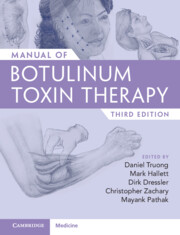Book contents
- Manual of Botulinum Toxin Therapy
- Manual of Botulinum Toxin Therapy
- Copyright page
- Dedication
- Contents
- Contributors
- Preface for the Third Edition
- Chapter 1 The Pretherapeutic History of Botulinum Neurotoxin
- Chapter 2 Botulinum Neurotoxin
- Chapter 3 Pharmacology of Botulinum Toxin Therapy
- Chapter 4 Immunological Properties of Botulinum Neurotoxins
- Chapter 5 Examination and Treatment of Complex Cervical Dystonia
- Chapter 6 Visualization of Ultrasound-Guided Intramuscular Injections in Muscles Relevant for Cervical Dystonia
- Chapter 7 Ultrasound Guidance for Botulinum Neurotoxin Therapy
- Chapter 8 Treatment of Cervical Dystonia
- Chapter 9 Treatment of Blepharospasm
- Chapter 10 Botulinum Neurotoxin in Oromandibular Dystonia
- Chapter 11 Botulinum Neurotoxin Therapy of Laryngeal Muscle Hyperactivity Syndromes
- Chapter 12 The Use of Botulinum Neurotoxin in Otorhinolaryngology
- Chapter 13 Treatment of Hemifacial Spasm with Botulinum Toxin
- Chapter 14 Botulinum Toxin in Treatment of Tics
- Chapter 15 The Use of Botulinum Toxin in Tremors
- Chapter 16 The Role of Ultrasound for Botulinum Neurotoxin Injection in childhood Spasticity
- Chapter 17 The Use of Botulinum Neurotoxin in Spastic Infantile Cerebral Palsy
- Chapter 18 The Use of Botulinum Neurotoxin in Spasticity Using Ultrasound Guidance
- Chapter 19 The Use of Botulinum Toxin in Spasticity
- Chapter 20 Treatment of Stiff-Person Syndrome with Botulinum Toxin
- Chapter 21 Botulinum Toxin in Ophthalmology
- Chapter 22 Cosmetic Uses of Botulinum Neurotoxins for the Upper Face
- Chapter 23 Botulinum Toxin for the Lower Face
- Chapter 24 Botulinum Toxin in the Treatment of Gummy Smile
- Chapter 25 Botulinum Toxin for the Breast
- Chapter 26 Treatment of Depression with Botulinum Toxin
- Chapter 27 Hyperhidrosis
- Chapter 28 Botulinum Toxin in the Treatment for Ischemic Digits and Chronic Pain
- Chapter 29 Botulinum Toxin in Wound Healing
- Chapter 30 Use of Botulinum Neurotoxin in Neuropathic Pain
- Chapter 31 The Use of Botulinum Toxin in the Management of Headache Disorders
- Chapter 32 Use of Botulinum Toxin in Musculoskeletal Pain and Arthritis
- Chapter 33 Treatment of Plantar Fasciitis/Plantar Fasciopathy with Botulinum Neurotoxins
- Chapter 34 Use of Botulinum Toxin in the Treatment of Low Back Pain
- Chapter 35 Use of Botulinum Neurotoxin in the Treatment of Piriformis Syndrome
- Chapter 36 Ultrasound-Guided Botulinum Toxin Injections for Thoracic Outlet Syndrome
- Chapter 37 Botulinum Neurotoxin in the Gastrointestinal Tract
- Chapter 38 Botulinum Neurotoxin Applications in Urological Disorders
- Chapter 39 Treatment of Focal Hand Dystonia
- Index
- References
Chapter 2 - Botulinum Neurotoxin
History of Clinical Development
Published online by Cambridge University Press: 02 November 2023
- Manual of Botulinum Toxin Therapy
- Manual of Botulinum Toxin Therapy
- Copyright page
- Dedication
- Contents
- Contributors
- Preface for the Third Edition
- Chapter 1 The Pretherapeutic History of Botulinum Neurotoxin
- Chapter 2 Botulinum Neurotoxin
- Chapter 3 Pharmacology of Botulinum Toxin Therapy
- Chapter 4 Immunological Properties of Botulinum Neurotoxins
- Chapter 5 Examination and Treatment of Complex Cervical Dystonia
- Chapter 6 Visualization of Ultrasound-Guided Intramuscular Injections in Muscles Relevant for Cervical Dystonia
- Chapter 7 Ultrasound Guidance for Botulinum Neurotoxin Therapy
- Chapter 8 Treatment of Cervical Dystonia
- Chapter 9 Treatment of Blepharospasm
- Chapter 10 Botulinum Neurotoxin in Oromandibular Dystonia
- Chapter 11 Botulinum Neurotoxin Therapy of Laryngeal Muscle Hyperactivity Syndromes
- Chapter 12 The Use of Botulinum Neurotoxin in Otorhinolaryngology
- Chapter 13 Treatment of Hemifacial Spasm with Botulinum Toxin
- Chapter 14 Botulinum Toxin in Treatment of Tics
- Chapter 15 The Use of Botulinum Toxin in Tremors
- Chapter 16 The Role of Ultrasound for Botulinum Neurotoxin Injection in childhood Spasticity
- Chapter 17 The Use of Botulinum Neurotoxin in Spastic Infantile Cerebral Palsy
- Chapter 18 The Use of Botulinum Neurotoxin in Spasticity Using Ultrasound Guidance
- Chapter 19 The Use of Botulinum Toxin in Spasticity
- Chapter 20 Treatment of Stiff-Person Syndrome with Botulinum Toxin
- Chapter 21 Botulinum Toxin in Ophthalmology
- Chapter 22 Cosmetic Uses of Botulinum Neurotoxins for the Upper Face
- Chapter 23 Botulinum Toxin for the Lower Face
- Chapter 24 Botulinum Toxin in the Treatment of Gummy Smile
- Chapter 25 Botulinum Toxin for the Breast
- Chapter 26 Treatment of Depression with Botulinum Toxin
- Chapter 27 Hyperhidrosis
- Chapter 28 Botulinum Toxin in the Treatment for Ischemic Digits and Chronic Pain
- Chapter 29 Botulinum Toxin in Wound Healing
- Chapter 30 Use of Botulinum Neurotoxin in Neuropathic Pain
- Chapter 31 The Use of Botulinum Toxin in the Management of Headache Disorders
- Chapter 32 Use of Botulinum Toxin in Musculoskeletal Pain and Arthritis
- Chapter 33 Treatment of Plantar Fasciitis/Plantar Fasciopathy with Botulinum Neurotoxins
- Chapter 34 Use of Botulinum Toxin in the Treatment of Low Back Pain
- Chapter 35 Use of Botulinum Neurotoxin in the Treatment of Piriformis Syndrome
- Chapter 36 Ultrasound-Guided Botulinum Toxin Injections for Thoracic Outlet Syndrome
- Chapter 37 Botulinum Neurotoxin in the Gastrointestinal Tract
- Chapter 38 Botulinum Neurotoxin Applications in Urological Disorders
- Chapter 39 Treatment of Focal Hand Dystonia
- Index
- References
Summary
In 1980, Alan B Scott published the use of botulinum neurotoxin type A by injection into extraocular muscles for treatment of strabismus. Use in blepharospasm was published in 1985, and cervical dystonia in 1986, followed by hemifacial spasm and other dystonias, including spasmodic dysphonia, hand dystonia, and conditions such as limb spasticity.
Formulations of neurotoxin type A worldwide include: Botox/onabotulinumtoxinA, Dysport/abobotulinumtoxinA, Xeomin/incobotulinumtoxinA, and a Chinese product marketed under various brand names in Asia. Botulinum neurotoxin type B is marketed as Neurobloc/Myobloc, or rimabotulinumtoxinB. PrabotulinumtoxinA and daxibotuinumtoxinA-Ianm are type A toxins under development.
Keywords
- Type
- Chapter
- Information
- Manual of Botulinum Toxin Therapy , pp. 9 - 12Publisher: Cambridge University PressPrint publication year: 2023

